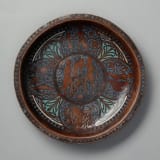


An enamelled gemellion with knights in combat
c. 1250
France, Limoges
23 cm (diameter) x 3 cm (depth); champlevé enamel on copper, with traces of gilding.
Gemellions, which appeared in the thirteenth century in the southern French enamel-producing centre of Limoges, were used for liturgical and secular hand washing. As their name indicates (derived from gemellus, the Latin word for ‘twin’), it is believed that such vessels were most often produced in pairs, with one bowl incorporating a small spout to pour water over the hands, and the other serving as a catch basin. Ours functioned as the latter, since it lacks a pouring spout.








